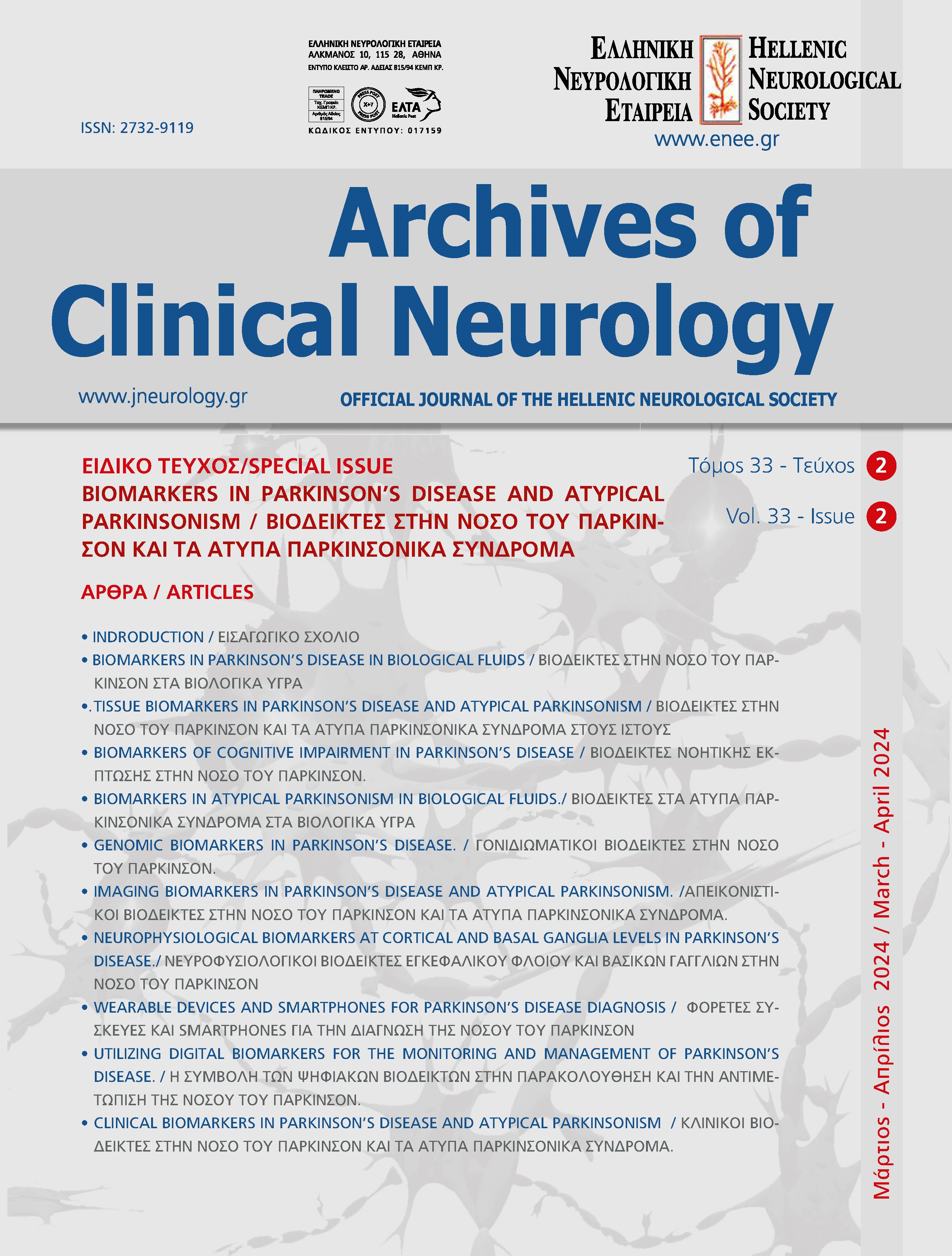ΚΛΙΝΙΚΟΙ ΒΙΟΔΕΙΚΤΕΣ ΣΤΗ ΝΟΣΟ ΠΑΡΚΙΝΣΟΝ ΚΑΙ ΣΤΟΝ ΑΤΥΠΟ ΠΑΡΚΙΝΣΟΝΙΣΜΟ
Λέξεις-κλειδιά:
νόσος Πάρκινσον, Άτυπα Παρκινσονικά σύνδρομα, Διαταραχή συμπεριφοράς ύπνου REM, κινητικός υπότυπος, ΥποσμίαΠερίληψη
Η χρήση κλινικών βιοδεικτών στη διαφορική διάγνωση και πρόγνωση των παρκινσονικών συνδρόμων πα-
ραμένει πολύτιμη, παρά την εξέλιξη στον εντοπισμό εργαστηριακών, απεικονιστικών και γενετικών δεικτών.
Στην παρούσα ανασκόπηση γίνεται αναφορά στα κριτήρια της Movement Disorders Society για την πρόδρο-
μη νόσο Πάρκινσον (ΝΠ) τα οποία αποσκοπούν στην αξιολόγηση της πιθανότητας παρουσίας πρόδρομης
ΝΠ σε άτομα χωρίς ή με πολύ ήπια κινητικά συμπτώματα. Περιγράφεται επίσης η προγνωστική αξία μεμο-
νωμένων βιοδεικτών για την ιδιοπαθή ΝΠ, όπως η ηλικία έναρξης και ο κινητικός υπότυπος, καθώς και η
προγνωστική αλλά και η διαφοροδιαγνωστική ικανότητα στο σύνολο των παρκινσονικών συνδρόμων της
διαταραχής συμπεριφοράς ύπνου REM, της υποσμίας, των διαταραχών οφθαλμοκινητικότητας, της ορθο-
στατικής υπότασης, της στοματοφαρυγγικής δυσλειτουργίας και ποικίλων νευροψυχιατρικών εκδηλώσεων.
Όσον αφορά τη διαταραχή συμπεριφοράς ύπνου REM, πέραν της υψηλότατης προγνωστικής της αξίας ως
πρόδρομης κατάστασης α-συνουκλεϊνοπάθειας, σημαντική είναι και η χρήση της στην ταξινόμηση των ασθε-
νών σύμφωνα με το προσφάτως προτεινόμενο μοντέλο κεντρικής ή περιφερικής έναρξης της παθολογίας α-
συνουκλεΐνης στην ιδιοπαθή ΝΠ. Η χρήση του μοντέλου αυτού επιφυλάσσει χρήσιμες παθοφυσιολογικές και
προγνωστικές προεκτάσεις όπως αυτές περιγράφονται συνοπτικά στο παρόν κείμενο. Τέλος, επισημαίνονται
βασικές παράμετροι οι οποίοι καθοδηγούν τη θεραπευτική στρατηγική στην ιδιοπαθή ΝΠ, όπως η ηλικία,
πιθανές συννοσηρότητες και ο τρόπος ζωής των ασθενών.


